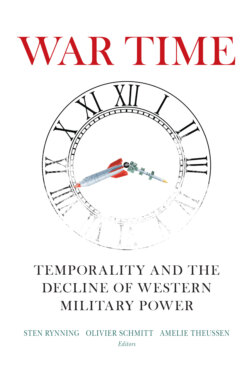Читать книгу War Time - Группа авторов - Страница 22
На сайте Литреса книга снята с продажи.
TWO Making Time an Ally
ОглавлениеUncovering the Perils of Tactical Military Speed
PAUL BRISTER
Military strategy scholars must be forgiven for advancing ideas of future warfare as a high-intensity, hyper-connected, and incredibly rapid activity. It has become near-impossible to discuss contemporary Western military strategy without hearing proclamations that the character of modern warfare is changing at accelerated rates; that the tempo of military operations must speed up; that forces must be deployed and employed faster to prevent an enemy fait accompli; that political leaders must make faster decisions to use military force; and that militaries must operate at “the speed of relevance.”1 The obsession with speed is ubiquitous, overwhelming, and dangerous. Moreover, it is revelatory of an institutional malaise caused by the failure of Western leaders to reconcile the slow pace of strategic affairs and the fast pace of tactical military operations. In important ways, therefore, the West has lost the “civic militarism” balance described in the previous chapter. This balance can be restored only if Western leaders and society identify and debate how technologies affect and shape the operational and strategic pace of their militaries.
There is little doubt that the pace of tactical military operations has accelerated. The proliferation of battlefield sensors combined with on-call standoff weapons require tactical units to constantly maneuver to ensure survival. As future weapons promise even greater speeds, the demand for lightning-fast attacks, greater battlefield dispersion, and constant repositioning of tactical assets will increase even more. Given the frightening pace of contemporary (and future) tactical operations, it is easy to see why Western defense scholars believe the effects of these tactical operations will naturally spill over into the operational and strategic levels of war, concomitantly accelerating each level. This is a problematic line of thought. History suggests that there is no such natural linkage between tactical speed and the pace required of higher operational and strategic logic.
Paradoxically, in fact, despite the accelerated speed of tactical operations, the pace and logic at higher levels of strategy may even have slowed.2 In light of this trend, the demands on future defense scholars and strategists are immense. They must convince political leaders to rise above the tyranny of the tactical/technological and prepare themselves instead for a long strategic game. This is a difficult proposition in ideal circumstances, but is made near-impossible by the unique demands of Western politics, acquisitions processes, and unrelenting partisan media cycles. This chapter seeks to demonstrate these paradoxical disconnects between the tactical and operational levels of modern strategy, specifically highlighting the seemingly inverse relationship between tactical speed and operational and strategic pace.
Pushing back against the “need for speed,” what is offered here is a more sanguine prediction with regard to the impacts of emerging technologies in future wars. The first section shows that recent calls for an increased speed of war follow a historical tradition, beginning in the Napoleonic era and running through the Iraqi “shock and awe” campaign. Although the terms of the argument have changed over time, its fundamental thrust has remained constant: that the investment in tactical military speed offers political leaders quick victories at minimal cost. Predictions of emerging technology have been used over time to bolster this argument. For over two hundred years, military strategists have pointed to the emerging technologies of their day and insisted that these systems would revolutionize war, offering a swift victory if only political leaders would allow them to strike first. For over two hundred years, these warfare prognosticators have gotten it wrong—often in bloody, tragic fashion. The second section offers an alternative perspective on the future of war, one dominated by pace-driven defensive strategies, rather than the speed-obsessed, short-duration “hyperwars” discussed within many Western military headquarters. The chapter closes with recommendations for policymakers, defense strategists, and strategic studies scholars facing the pressure of a speed-obsessed military and the industries that fuel it.
